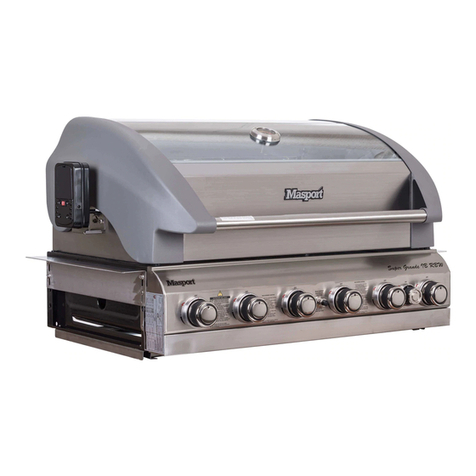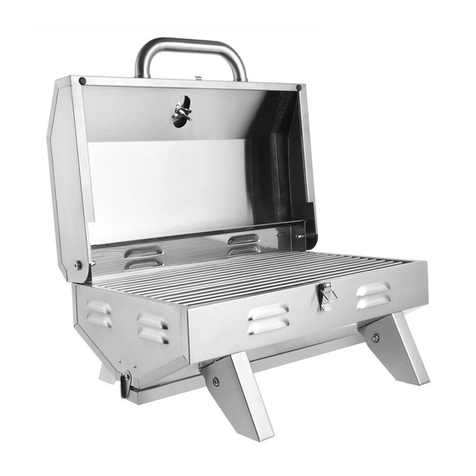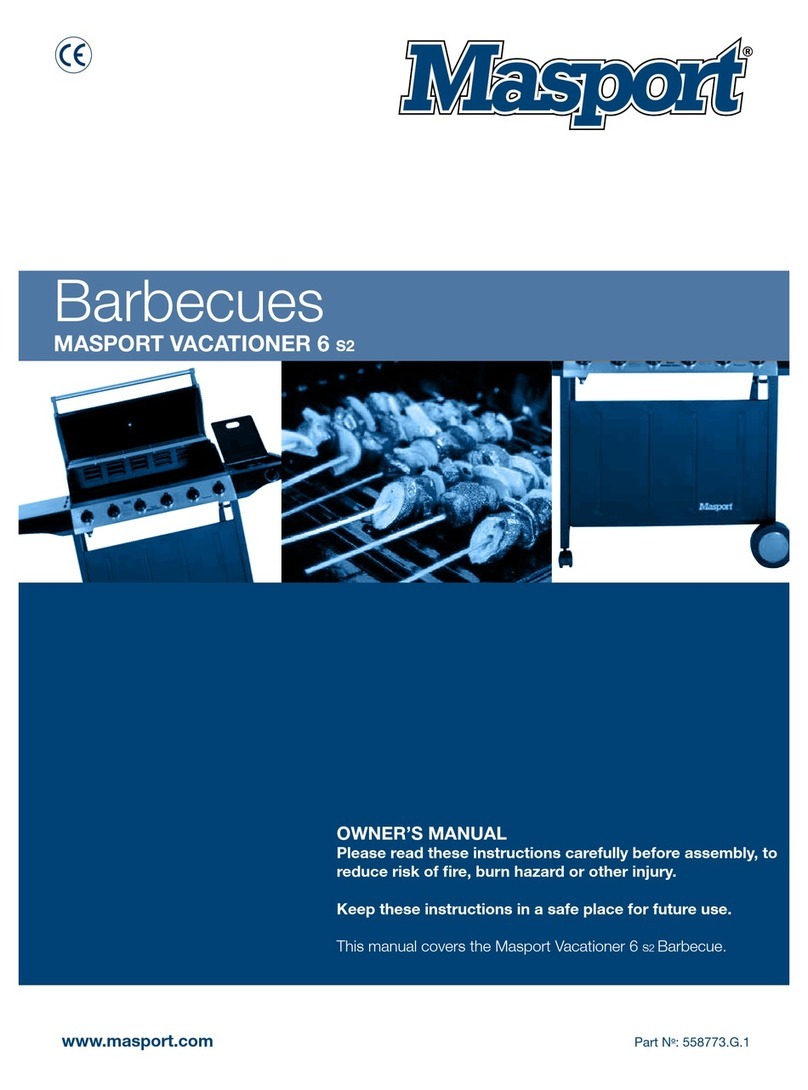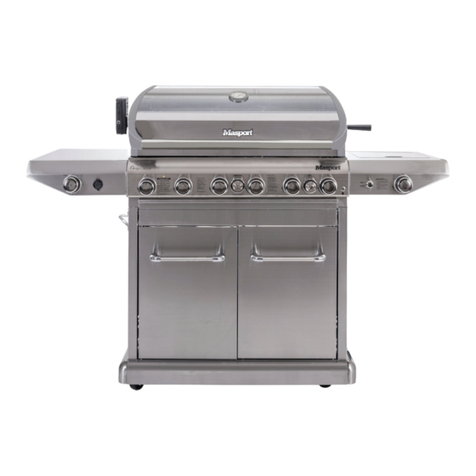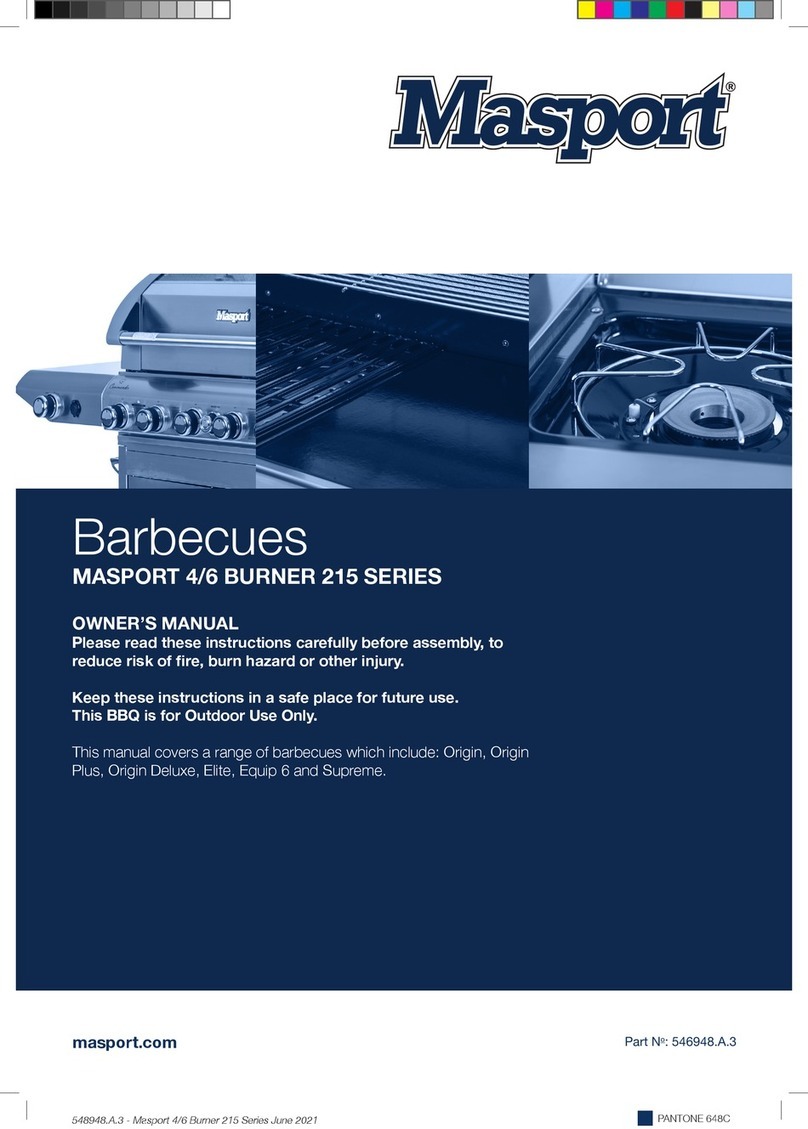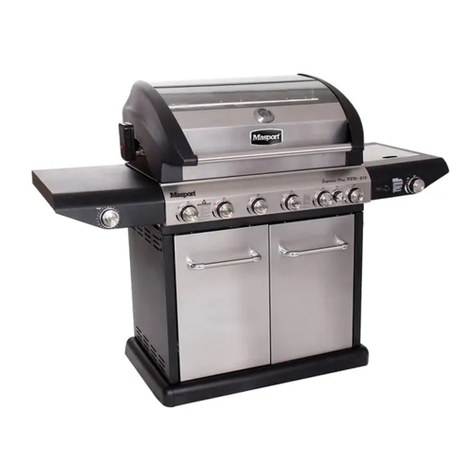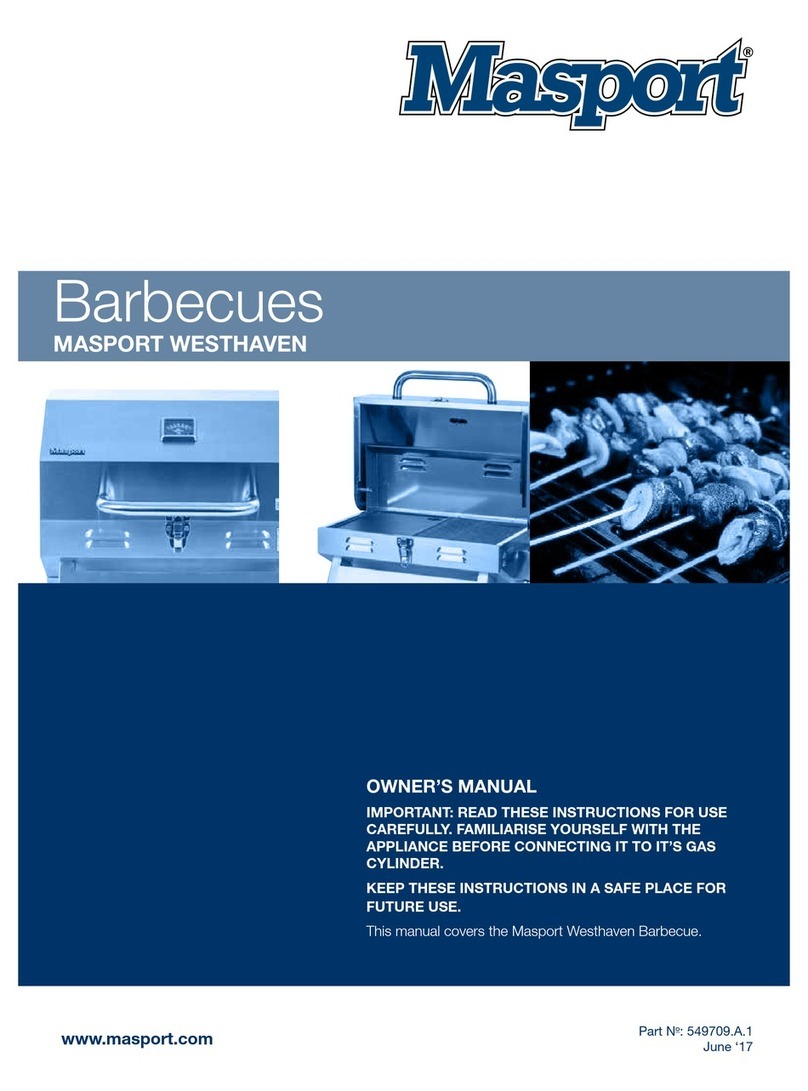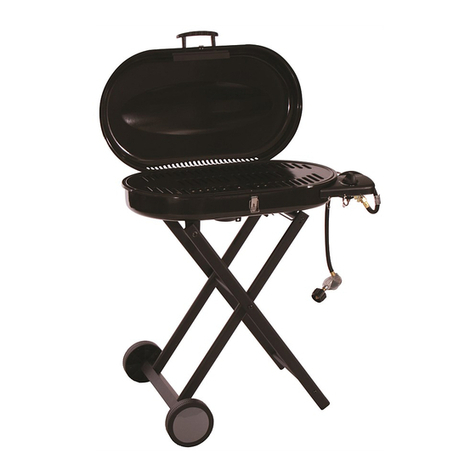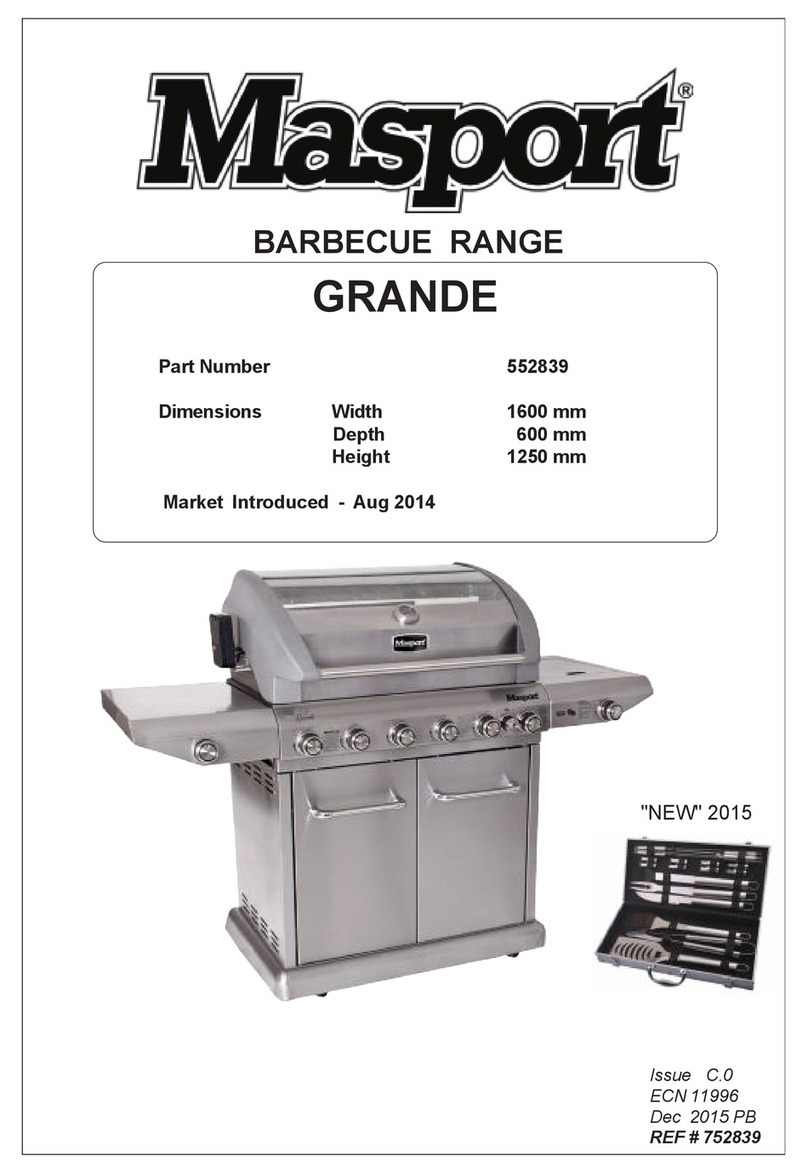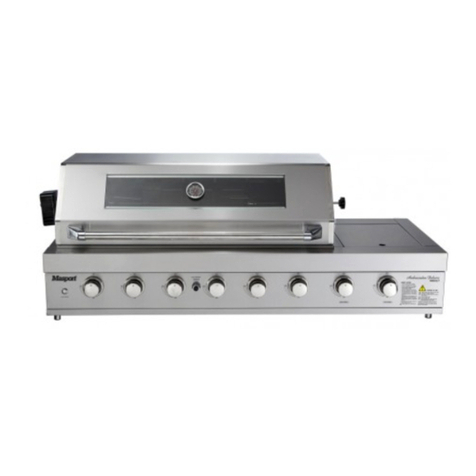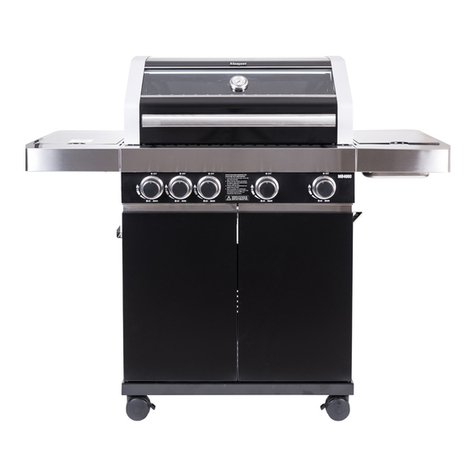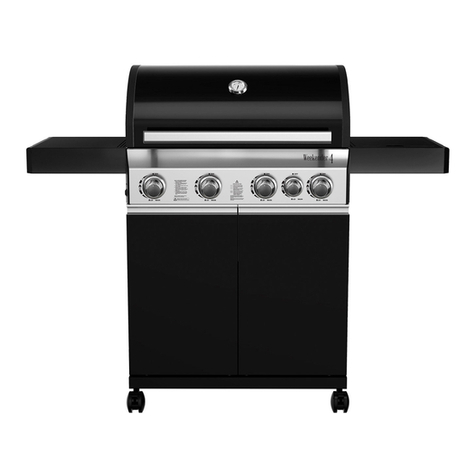
1918
LIGHTING THE BBQ
Lighting the BBQ is easy, but must be done with due care.
Make sure that the gas is turned on at the cylinder, or that gas is
available to the BBQ. Ensure that the hood is open.
DIFFICULTY LIGHTING
If the burner doesn’t light first go, check the gas controls and try
a couple more times. If the burner still does not light, wait a few
minutes to allow the gas to disperse before trying again. If satisfactory
operation cannot be achieved, refer to the troubleshooting guide in
this manual or consult your retailer before proceeding.
Note: Failure to follow the lighting procedures correctly can lead to a
hazardous situation.
MAIN BURNER LIGHTING (INTEGRATED IGNITION)
1.Open the lid before igniting the barbecue
2.Check all the knobs are in the “•” (OFF) position
3.Open the gas control valve at the gas cylinder
NOTE: The valves fitted to this BBQ include a safety feature.
The valve must be depressed before turning. This feature
prevents accidental activation of the knob
4.From the “•” (OFF) position, push in then turn the control knob
anti-clockwise to the “ ” (ON) position until hearing a “click”
sound
5.Repeat step 4, 3-4 times until the burner is lit
6.If the burner fails to light, turn off and wait for 5 minutes, then
begin from step 4
7.Once a burner is lit, similarly light the remaining burners.
8.Turn the knob anticlockwise to adjust the heat. Heat can be
adjusted on a continuous scale where:
• 90 degrees to the left is the lowest burner setting
• 180 degrees, vertically down is the highest burner setting
FOR MANUAL LIGHTING (MAIN BURNER)
IMPORTANT
Use a match holder and long match stick or BBQ lighter
for lighting the BBQ manually to avoid burning your hand.
1. Open the lid before igniting the barbecue.
2. Check all the knobs are in the “•” (OFF) position.
3. Open the gas control valve at the gas cylinder.
4. From the “•” (OFF) position, push in and then turn the control
knob anticlockwise to the “ ” (ON) position.
5. Hold a lit match (in a match holder) next to one of the main
burners. The burner will light from the match.
Once a burner is lit, the burner next to it can be turned on and will
light off the lit burner. Repeat until all burners are alight.
Each burner can be adjusted. Turn the knob anticlockwise to adjust
the heat from High - medium - Low to your heat requirement.
IMPORTANT
Keep a spray bottle of soapy water near the gas supply
valve and check the connections before each use.
WARNING!
• Do not light the grill if odour of gas is present.
• It is important to ensure that all control valves, including the
gas cylinder, are turned off after use.
• Caution / Danger: Extreme care is required when cooking
with hood in closed position. Frequent checks must be
undertaken for the heat and temperature to ensure safe
cooking.
• Too much heat can cause fire.
TURNING OFF A BURNER
Push in then turn each burner control knob clockwise to the “•”
position.
TURNING OFF YOUR BARBECUE
When you have finished using your barbecue, turn off the gas at the
bottle. Push in and then turn all the control valves fully clockwise to
the “•” position. Wait until the barbecue is sufficiently cool before
replacing the barbecue lid or closing its hood. Once cooled, a
protective cover should always be fitted to the barbecue to protect it
from atmospheric conditions.
LED KNOBS
This knobs on this barbecue are equipped with LED lights. To operate
the LED lights, three charged AA batteries must be installed in the
battery box. Batteries are not included with the barbecue. To turn the
LED lights on and off, press the toggle switch on the left-hand side
of the fascia.
GRILL COOKING
The natural juices produced during cooking fall into the body below
and vaporise. The subsequent rising smoke bastes the food, as it
travels upwards, imparting that unique barbecue flavour.
FLAT/FLAT-RIBBED PLATE
The burners heat the griddle plate directly, which then cooks the food
on contact. They are also suitable for cooking items that require high-
temperature/short-duration cooking, such as vegetables and smaller
cuts of fish. Similarly, these can be used in exactly the same way as a
griddle in the kitchen, for searing steaks, cooking eggs, etc.
DO NOT use the reverse faces of the left and right cookware.
The centre plate will not be secure, risking damage to the
barbecue or injury.
COOKING AND USE OF HOOD
The barbecue is equipped with a roasting hood, giving the option of
cooking with hood closed to form an ‘oven’ for roasting food, such
as joints of meat, whole chickens, etc.
WARNING!
Cooking with the hood closed and the burners on high creates
a fire risk. When the hood is closed, a large amount of heat is
trapped inside the barbecue. Thus, it is IMPORTANT to make
sure that all the burners are turned to the low position to prevent
burning of the food and damaging the barbecue. Avoid lifting the
hood unnecessarily as heat is lost every time the hood is opened.
Use the temperature gauge to check the heat of the barbecue.
DO NOT ALLOW YOUR BARBECUE TO OVERHEAT. A
BARBECUE SHOULD NEVER BE LEFT UNATTENDED
WHILE COOKING!
For safety reasons, barbecue plates and grills will not cook as hot
towards the front of the barbecue.
FRONT
The slightly lower temperature at the front can easily be overcome
by rotating the food being cooked around the barbecue plate or grill.
CHECKLIST
Problems Possible Cause Solutions
Integrated Ignition
When push the knob and turn anticlockwise:
- Won’t light Orifice blocked Check the orifice for blockage
- No spark Dirty contacts of the electrode and or loose contacts Remove the connecting wire, clean and reconnect
firmly
- Still no spark Electrode terminals are damaged Inspect electrode and replace if damage
- Weak spark Due to moisture / food residue on the electrodes Remove the moisture using paper towel / clean the
electrode
- Spark at places other than the tip of electrode Ignition wire damaged Replace the ignition wire
Burner can’t light by match No gas Open the LP tank valve
Gas flow is not smooth Clear burner tubes
Incorrect assembly between burner and valve Re-assemble
Yellow or orange flames, with gas odour Incomplete combustion Check the burner inlet for obstructions such as
spiders
Check air shutter for correct adjustment
Check for the source
Low heat with knob in “high” position Gas hose bent or kinked Straighten
Burner or orifice blocked Clear
Low gas pressure Check Cylinder/ Regulator
Grill not preheated Preheat the grill for 15 minutes
Flare up Excessive meat fat Cut off fat before grilling
Excessive temperature Adjust knobs
Grease deposit Clean
Flame out Excessive winds Find a less windy place
Flame lifting Excessive gas pressure Call the gas dealer
Flashback Burner port blocked Clean
Grease fire Grease accumulated in food Turn off knobs, LP tank valve, leave lid open, let fire
burn out. Clean the grill when cool.
BEFORE CALLING FOR SERVICE
If the grill does not function properly, use the following checklist
before contacting your dealer for service.
APPLIANCE APPROVED FOR OUTDOOR USE ONLY
USE ONLY THE 5/8” x 18 GAS CONNECTION HOSE AND
REGULATOR PROVIDED BY THE MANUFACTURER!
If a replacement is necessary, please contact either our Customer
Service Department or your local dealer.
The use of unauthorised parts can create unsafe conditions and will
void your warranty. Refer to the warranty terms at the end of this
owner’s manual for further information.
STORAGE OF THE GRILL
1. Clean the BBQ.
2. Store the BBQ outdoors in a dry, well ventilated area and out
of reach of children when LP tank is connected to the grill. Use
the supplied BBQ cover to protect the BBQ from environmental
conditions.
3. Store the BBQ indoors ONLY after the LP tank is turned off and
removed, the LP tank must be stored outdoors, out of reach of
children, NEVER store the tank in a building, garage or any other
enclosed area.
4. If using a cover for your barbecue, check your BBQ every few
weeks.
TROUBLESHOOTING
FLARE-UP CONTROL
Flare-ups occur when meat is barbecued, and its fats and juices
fall. The smoke from some flare-up helps give cooked meat its
barbecued flavour, but excessive flare-up will result in meat being
burned. To control flare-up, it is advisable to trim away excess fat
from meat and poultry before grilling. Also, the burners should always
be placed on the low setting during cooking. Finally, extinguish flare-
ups by applying baking soda or salt directly onto the flame tamers.
Always protect your hands when handling anything near the cooking
surface of the barbecue.
If a fat fire should occur in the drip tray, turn all knobs to the off
position, turn off the gas at the bottle, and wait for the fire to go out.
Do not pull out the drip tray or douse with water.
WARNING!
• Caution / Danger: Extreme care is required when cooking
with hood in closed position. Temperature of the BBQ must be
closely monitored to ensure it remains at a safe level.
• Too much heat can cause fire.
To look after your BBQ, do not cook with the Hood down at High
temperature for long periods of time. Use the BBQ cover when
BBQ is not being used to protect it from photo-degradation in direct
sunlight.
